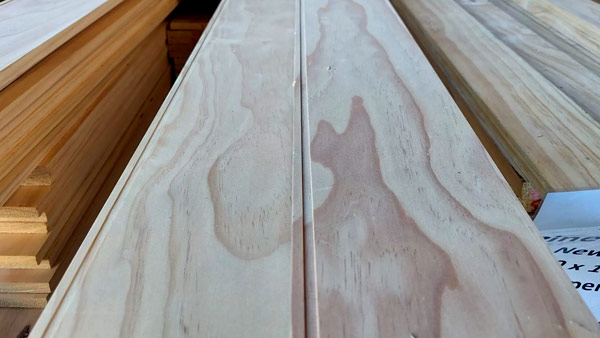Radiata Pine timber is indispensable in New Zealand, serving diverse roles. Its fast growth and adaptability make it a prime choice for construction, from framing to flooring. It excels in producing furniture, cabinetry, and veneers due to its fine grain and easy workability. This timber finds purpose in crafting doors, windows, and paneling. The packaging industry benefits from its strength for creating pallets and crates. Moreover, its renewable nature aligns with sustainability goals. Radiata Pine timber stands as a cornerstone of New Zealand’s woodworking industry, enriching construction, design, and various everyday essentials.

Uses
- Suitable for practically all building components if correctly processed
Selection factors
- Easy to work for structural purposes
- Clear timber is available for appearance uses
- Accepts paint and clear coatings easily
- Hardened radiata pine (called Pacific pine and available in New Zealand) is suitable for bench tops and flooring, etc.
- Proprietary laminated radiata pin T&G flooring, V-jointed on the underside, in thicknesses between 50 mm and 135 mm, can be exposed on the underside to form the ceiling.
| Common names | Radiata pine, Monterey pine; insignis pine; remarkable pine |
| Species | Pinus radiata |
| General description | – Heartwood is light brown – Sapwood is creamy white – Prominent growth rings – Large loose pith surrounded by corewood which is less dense and shrinks excessively – Softwood |
| Origin | Monterey Peninsular, California |
| Sustainability | There are large plantations in Australia and New Zealand |
| Availability | Processed timber for a wide range of uses is readily available. New Zealand-grown kiln-dried timber is imported into Australia |
| Durability & treatment | Non-durable but readily accepts all levels of chemical treatment |
| Drying | Easy to season. Most finishing and structural timber is kiln dried. |
Technical Specs
| Physical Characteristics | ||
|---|---|---|
| Shrinkage | Tangential | 4.7% |
| Radial | 2.2% | |
| Strength group | Unseasoned | S6 |
| Seasoned | SD 7 | |
| Density | 450-550 | |
| Hardness | 3.3 | |
| Durability Class | 4 |
| Exposure of component | Treatment or comment |
|---|---|
| Ground contact – critical | H5 |
| Ground contact – non-critical | H4 |
| Exposed to termite | H2 |
| External – exposed | H3.2 |
| External – sheltered from the weather by painting | H3.1 |
| Internal – Green framing | H1.1 |
| Internal – Framing dry low risk | Kiln-dried untreated timber |
